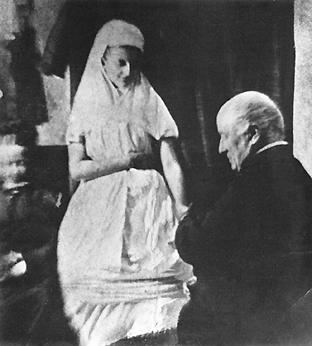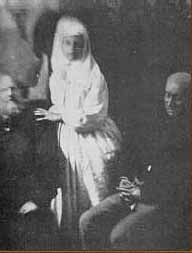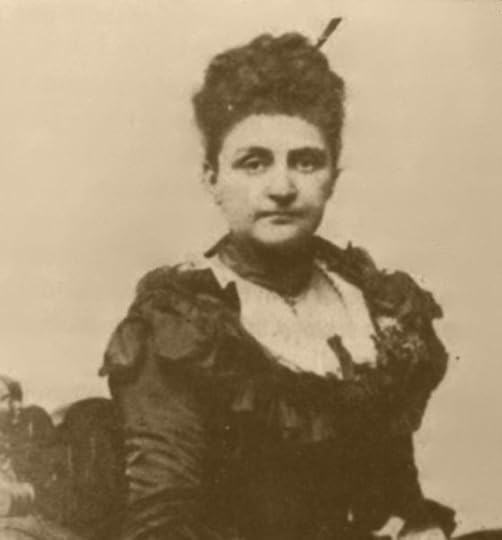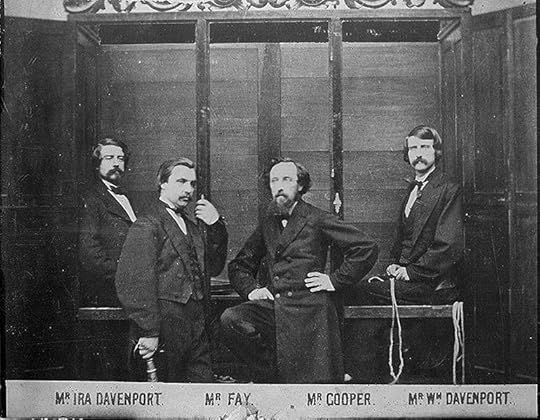Michael Gallagher's Blog - Posts Tagged "volckmann"
Why the Victorians saw ghosts: the full-body materializations of Florence Cook
 While I was researching my novel,
The Bridge of Dead Things
, I came to understand that the Victorian vogue for spiritualism did not happen in a vacuum. It grew out of a very specific culture, at a particular point in time, and it fulfilled a number of surprisingly different needs. This is the seventh in a series of posts that examines various influences on the development of spiritualism. **Please note that it is edited from articles that I have previously posted, but its inclusion here helps to make sense of the history.**
While I was researching my novel,
The Bridge of Dead Things
, I came to understand that the Victorian vogue for spiritualism did not happen in a vacuum. It grew out of a very specific culture, at a particular point in time, and it fulfilled a number of surprisingly different needs. This is the seventh in a series of posts that examines various influences on the development of spiritualism. **Please note that it is edited from articles that I have previously posted, but its inclusion here helps to make sense of the history.**Florence Eliza Cook was born on June 3rd 1856 in Cobham, Kent to parents Henry and Emma Cook, who moved to London when she was three and took up residence at 6 Bruce Villas, Eleanor Road, Dalston. She was the eldest of four children.
In 1870, at the age of fourteen, she began table-rapping experiments with her friends and family, surprising everyone when a violent burst of poltergeist activity ensued. A spirit responding to her questions through a system of yes-or-no raps informed her that she was indeed a medium and then directed her to the local Spiritualist Association. By the following year she'd started working for a pair of established mediums, Frank Herne and Charles Williams, and reports of her séances were beginning to crop up in the spiritualist press. Herne's spirit-guide was an entity named John King, who rather confusingly claimed to be the ghost of Sir Henry Morgan, the famous buccaneering pirate. Florence's guide was Katie King, John's daughter, who also claimed to be Annie Owens Morgan, the daughter of the pirate. At this point there was none of the bodily manifestations of Katie that came later; there were simply disembodied voices, messages written by unseen hands, and phenomena known as "apports"—objects that appeared to fall from the ceiling.
There is a truly fascinating story of one such occurrence: early in the June of 1871 Herne and Williams were conducting a séance together for eight sitters around a table at 69 Lamb's Conduit Street when the voices of Katie King and her father were heard in the darkness. Katie offered to produce a gift for the group and one of the sitters suggested—half jokingly—that she bring them Agnes Guppy, an extremely stout medium famed for her own apports who lived some miles away in Highbury. Katie laughed—everybody laughed—and though her father protested she agreed to go through with it. Suddenly there was a loud thump; somebody screamed. When one of the company had the presence of mind to light a lamp, there on the table in front of them, apparently in some kind of trance, was perched the stout Mrs Guppy in a state of semi-undress, account book and pen still in hand.

By the beginning of 1873 Florence was performing her own séances at the Cook family home in Dalston, but by now there were full materialisations. The audience, often comprised of highly respectable professional men and women, would sit in the dimly-lit parlour while Florence was bound by ropes before retiring to an adjoining room screened off from view by a thin damask curtain. Presently the spirit of Katie King would appear dressed in white, and walk about the room telling the story of her former life as Annie Morgan, the buccaneer's daughter. It was a charming tale. Annie had been twelve years old when Charles the First was beheaded; she'd married and had two little children; she'd committed more crimes than she cared to confess; she'd even murdered men with her own two hands; she'd died young. To questions concerning the reason of her reappearance back on earth, she claimed that it was part of the work she'd been entrusted with, to convince the world of the truth of Spiritualism.
In Spring of that year Florence Cook held a series of sittings designed to capture a photographic likeness of Katie. On the 7th of May, Mr W. H. Harrison, a reporter for the Daily Telegraph (who in later years went on to edit The Spiritualist, a London-based magazine dedicated to examining spiritualist phenomena from a scientific perspective), successfully managed to take the first four photographs of Katie. More sittings followed where the highly respected scientist William Crookes took a total of forty-four photos, all the while performing tests on Florence as part of his on-going investigation into spiritualist mediums. These sittings were held at Crookes's own house on Regent's Park, which was one of the conditions he imposed on all his test subjects.
Florence was fast becoming famous, but fame breeds jealousy. At a séance held on the 9th of December the lawyer William Volckmann seized Katie King by the waist and refused to let go. Some of those present claimed that the spirit "glided" out of Volckmann's grip; others suggest that she defended herself quite vigorously (Volckmann lost part of his beard). Edward Elgie Corner, a ship's captain from Dalston, who was a family friend of the Cooks as well as being their neighbour, together with another of her supporters rushed to Katie's aid. The gaslights were rapidly extinguished, there was a great deal of scuffling, and by the time peace was eventually restored and the room re-lit, Katie King had vanished and Florence was discovered still secured by her ropes. As Volckmann was most likely in league with Agnes Guppy (the formidable medium from Highbury who'd landed on the table in a state of semi-undress—whom he in fact married after her elderly husband passed away barely a year later), it would seem that Florence's relationship with her erstwhile colleague had soured considerably.

Volckmann's attack damaged her reputation. Unfortunately Crookes's report, Notes of an Enquiry into the Phenomena called Spiritual during the Years 1870-1873, published a month later in the Quarterly Journal of Science (January 1874) did little to restore it, despite his vehement assertion that Florence Cook, the American Kate Fox, and the Scotsman Daniel Dunglas Home, were all genuine mediums producing perfectly genuine results.
The séances continued. Florence teamed up with another girl, Mary Rosina Showers. The pair gave a séance at the Crookes home in March of 1874 which was attended by a number of witnesses, among them the barrister, Serjeant-at-law Edward William Cox. Cox took a deep—though not uncritical—interest in spiritualism; it was he who had first hosted and championed Daniel Dunglas Home on his return from America. He published his observations some weeks later in The Spiritualist, the leading newspaper in its field, which the reporter W. H. Harrison would go on to edit. Of the materialisations he wrote: "They were solid flesh and blood and bone. They breathed, and perspired, and ate…Not merely did they resemble their respective mediums, they were…alike in face, hair, complexion, teeth, eyes, hands, and movements of the body…"
As regards proof that they were not simply the two girls themselves, he wrote: "…no proof whatever was given or offered or permitted. The fact might have been established in a moment beyond all doubt by the simple process of opening the curtain and exhibiting the two ladies then and there upon the sofa, wearing their black gowns. But this only certain evidence was not proffered, nor, indeed, was it allowed us…"
On the 29th of April 1874 Florence Cook married Captain Edward Elgie Corner, the neighbour who had rushed to Katie's aid the previous December. Though their marriage was blessed with two daughters, Kate and Edith, it was not a happy one.

The final appearance of Katie King was a truly sad occasion. She had often stated that she could not appear on this earth beyond the month of May, 1874, and so, on the 21st, she assembled her friends together to bid them all goodbye. This eye-witness account was written by the stage actress and internationally successful author Florence Marryat:
"Katie had asked Miss Cook to provide her with a large basket of flowers and ribbons, and she sat on the floor and made up a bouquet for each of her friends to keep in remembrance of her. Mine, which consists of lilies of the valley and pink geranium, looks almost as fresh to-day, nearly seventeen years after, as it did when she gave it to me. It was accompanied by the following words, which Katie wrote on a sheet of paper in my presence: 'From Annie Owen de Morgan (alias "Katie") to her friend Florence Marryat Ross-Church. With love. Pensez à Moi. May 21st 1874.' The farewell scene was as pathetic as if we had been parting with a dear companion by death. Katie herself did not seem to know how to go. She returned again and again to have a last look, especially at Mr. Alfred [William] Crookes, who was as attached to her as she was to him."
Of that final parting, this is what William Crookes himself wrote: "Having concluded her directions, Katie invited me into the cabinet with her, and allowed me to remain there to the end. After closing the curtain she conversed with me for some time, and then walked across the room to where Miss Cook was lying senseless on the floor. Stooping over her, Katie touched her and said, 'Wake up, Florrie, wake up! I must leave you now.' Miss Cook then woke and tearfully entreated Katie to stay a little time longer. 'My dear, I can't; my work is done. God bless you!'…For several minutes the two were conversing with each other, till at last Miss Cook's tears prevented her speaking. Following Katie's instructions, I then came forward to support Miss Cook, who was falling on to the floor, sobbing hysterically. I looked around, but the white-robed Katie had gone…"
It would be impossible not to compare Cox's statement with that of Crookes's, or Florence's likeness with that of Katie's. But I will tell you this: I am absolutely convinced that William Crookes was not lying about what he saw.
Though Katie was never to appear again, Florence went on to host two further spirit-guides during her lifetime: firstly Leila in 1875 (the same year that Frank Herne, the medium who'd set Florence on her career-path was debunked as a fraud), and then later a French girl who called herself Marie, who was said to have "danced and sung in a truly professional style".
Five years on, Florence was ghost-grabbed for a second time, on this occasion by the young Sir George Sitwell, a 20-year-old Oxford University student, at a public séance being given at the rooms of the National British Association of Spiritualists in 1880. The débâcle ruined her, and she retired and moved to Wales. The incident brought Sir George some notoriety too and he soon left Oxford without taking a degree. He ended up fathering a daughter, the future Dame Edith Sitwell, truly England's most eccentric poet who became something of an entertainer herself. In 1923 she alienated her audience by standing out of sight behind a starkly-painted screen while shouting her poems at them through a megaphone, all in time to William Walton's carefully arranged score of Façade – An Entertainment.
In 1899 Florence tried to revive her career when she was invited to Berlin to undertake a series of séances under test conditions by the Sphinx Society. She died of pneumonia in relative poverty at 20 Battersea Rise, London, on the 22nd of April 1904 at the age of 48. Her husband outlived her by a quarter of a century and died in 1928.
William Crookes received his knighthood in 1897 and the Order of Merit in 1910. He died in 1919. Towards the end of his life he sought out mediums to help him communicate with his beloved wife, who had predeceased him by two years.
I'd like the last words to go to the fifteen-year-old Florence Cook herself. In a letter to Mr W. H. Harrison (the Telegraph reporter who would later take the first photographs of Katie), dated May, 1872, she writes: "From my childhood I could see spirits and hear voices, and was addicted to sitting by myself talking to what I declared to be living people. As no one else could see or hear anything, my parents tried to make me believe it was all imagination, but I would not alter my belief…"

Next month: Caught on camera—the darker role that photography played in spiritualism
Find out more at michaelgallagherwrites.com

Why the Victorians Saw Ghosts – An Illustrated Guide to 19th Century Spiritualism is now available as an ebook. Visit the “My Shout” page on my website for details of a free download.
Images:
Florence Cook (1856-1904)
Photographer and date unknown
Katie King
Photograph by William Crookes (1832-1919), circa 1873/1874
Katie King
Photograph by William Crookes (1832-1919), circa 1873/1874
Mrs Edward Elgie Corner (1856-1904)
Photographer and date unknown
Published on January 01, 2014 06:32
•
Tags:
agnes-guppy, crookes, edward-william-cox, florence-cook, katie-king, marryat, materializing-medium, rosina-showers, spiritualism, spiritualists, victorian-mediums, victorian-seances, volckmann
Why the Victorians saw ghosts: Ghost-grabbers—tackling the spirits head-on
 While I was researching my novel,
The Bridge of Dead Things
, I came to understand that the Victorian vogue for spiritualism did not happen in a vacuum. It grew out of a very specific culture, at a particular point in time, and it fulfilled a number of surprisingly different needs. This is the ninth in a series of posts that examines various influences on the development of spiritualism.
While I was researching my novel,
The Bridge of Dead Things
, I came to understand that the Victorian vogue for spiritualism did not happen in a vacuum. It grew out of a very specific culture, at a particular point in time, and it fulfilled a number of surprisingly different needs. This is the ninth in a series of posts that examines various influences on the development of spiritualism.So far in this history we've already encountered a number of ghost-grabbers: Noah Brooks, the American journalist with the Sacramento Daily Union, who literally grabbed the trance medium Lord Colchester's hand at a séance instigated by Mary Todd Lincoln, and the English lawyer, William Volckmann, who seized the spirit of Katie King by the waist and refused to let go—despite being tackled by two of Florence Cook's confederates who were stationed in the audience, one of whom she ended up marrying a mere four months later. Both instances were brutal and bloody. Brooks received a blow to his forehead with a drum that Colchester used in his performance; Volckmann, who was in league with the medium Agnes Guppy—one of Florence's rivals—had part of his beard torn away. Florence was ghost-grabbed again some years later, you may recall, this time by the twenty-year-old Sir George Sitwell at the assembly rooms of the National British Association of Spiritualists in 1880. It spelled the end of her career. She was forced to retire and move to Wales.
Another victim to be caught out several times was the medium Henry Slade (1835-1905), who was noted for his chalked spirit messages that would "miraculously" appear on a conveniently-held slate. Having been twice unmasked as a fraud in America (first by John W. Truesdell in 1872, then by Stanley LeFevre Krebs), he came to Britain to ply his trade. Here he was thwarted by Ray Lankester (1847-1929), a twenty-nine-year-old professor of zoology at University College London, who in 1876 snatched the pre-inscribed slate from the medium's grasp. Slade was brought to trial and found guilty of fraud, but successfully appealed his conviction on a technicality, that the original charge had omitted the words "by palmistry or otherwise". Before fresh charges could be brought he'd fled the country and returned to America.

Ghost-grabber Lankester was one of a growing group of scientific men, as was William Benjamin Carpenter (1813-1885), a colleague of his who had recently been appointed Registrar of the University of London, and Lyttleton Stewart Forbes Winslow (1844-1913), an alienist (an early form of psychologist), all of whom were beginning to challenge the most basic precepts of spiritualism, possibly as a reaction to William Crookes's reviled report, Notes of an Enquiry into the Phenomena called Spiritual, published some two years before Slade's trial. Winslow (or Forbes-Winslow, as he eventually came to style himself) used red ink in pursuit of charlatans. He would squirt it in the faces of any spirits that happened to materialize in his presence. He's a fascinating character who I will return to in the next post.
But it wasn't just scientists who worked to unmask frauds. It was often stage magicians who proved far more ruthless as opponents. Even by the mid-1860s a professional hatred had emerged that separated stage magicians, who claimed no spiritual intervention for their illusions, from spiritualist mediums, who did. Such was the case with the two Davenport brothers, Ira and William, who like Maria B. Hayden and Daniel Dunglas Home before them, came to Britain from America either at the end of 1864 or the beginning of 1865.
Ira Davenport was born in the September of 1839; his brother William was born less than two years later in 1841. They were the sons of a policeman and grew up in Buffalo, New York. They claimed to have discovered their mediumistic powers when Fox-style rappings broke out at their house in 1846, two years before those of the Fox sisters, when Ira was seven years old and William barely five. By 1854, when both boys were still teenagers, they had already come up with the basic building blocks of their act. Managed by their father, tutored by a local amateur conjurer, William Fay, and introduced on stage by Dr J. B. Ferguson, a former minister of religion who truly believed in the brothers' spiritualistic abilities, they started giving shows across America, from which they earned their living for the next ten years.
While the séances of Maria B. Hayden and Daniel Dunglas Home may have relied rather heavily on creating a specific eerie atmosphere where people's heightened senses would cause them to jump out of their skin at the slightest unexpected sound, the Davenports took the opposite view: they relied on overkill. Their act was designed as a public performance, where the people in the back stalls could see and hear everything that happened equally as well as those at the front—and see and hear it they did!
Bound hand and foot by ropes that were then sealed with sealing-wax, and subsequently shut inside their "spirit cabinet", the brothers would make a racket with an array of musical instruments that had been placed on the cabinet floor. The two cabinet doors would alternately burst open and slam shut, revealing one bound brother then the other, while instruments went flying through the air, often being hurled directly into the audience.
In England the Davenports initially found some support. Richard Burton, the translator of—for its time—the extremely racy Arabian Nights had this to say in their defence: "I have spent a great part of my life in Oriental lands, and have seen their many magicians. Lately I have been permitted to see and be present at the performances of Messrs. Anderson and Tolmaque. The latter showed, as they profess, clever conjuring, but they do not even attempt what the Messrs. Davenport and Fay succeed in doing…"
Unfortunately a number of amateur British magicians disagreed. Two of their ilk joined the tour in Liverpool in the February of 1865 and, upon "volunteering" from the audience, bound the brothers' hands so tight with knots that couldn't be undone that their wrists bled. The Davenport brothers were eventually cut free but refused to continue. The audience, unimpressed by what they'd witnessed, stormed the stage and smashed their cabinet to pieces. The perpetrators of the knot-tying struck again at their gig in Huddersfield—then later at Leeds—and each time they did, the violence escalated. Ira and William cancelled their remaining English dates and took their show to Europe.
But a twenty-five-year-old watchmaker named John Nevil Maskelyne, who had seen the brothers' act, had worked out how the trick was managed. He and his friend, George Alfred Cooke, built their own spirit cabinet and gave their own public demonstration—minus all spiritualist trappings—in June of 1865. Word of their performance was rapidly spread by the fascinated British press. Their success in unmasking the Davenports ignited their passion for stage magic, and the two went on to create many further illusions, some of which are still performed today.
As for the Davenports, the youngest brother, William, died in 1877 in Sydney, Australia, at the age of thirty-six. Ira moved back to America, where died in 1911. Before his death he wrote to Harry Houdini, famous escapologist and unmasker of psychics, claiming that he and William had never publicly stated their belief in spiritualism. But the truth is probably best represented by Ira's obituary in one American newspaper: "They made the mistake of appearing as sorcerers instead of as honest conjurers. If, like their conqueror, Maskelyne, they had thought of saying, 'It's so simple,' the brethren might have achieved not only fortune but respectability."

Next month: Mediumistic or mad?—the precarious position of women who dared to be spiritualists
Find out more at michaelgallagherwrites.com
Images:
Carte-de-visite of John Nevil Maskelyne, illusionist and magician (1839-1917)
Photographer and date unknown
Henry Slade (1835-1905)
The Davenport brothers seated in their spirit cabinet, with their asscociates Mr Fay and Mr Cooper in the foreground
Photographer unknown; 1870

Why the Victorians Saw Ghosts – An Illustrated Guide to 19th Century Spiritualism is now available as an ebook. Visit my website for details of a free download.
Published on March 01, 2014 06:20
•
Tags:
agnes-guppy, davenport-brothers, florence-cook, forbes-winslow, ghost-grabbers, henry-slade, houdini, katie-king, lankester, lord-colchester, mary-lincoln, maskelyne, mediums, noah-brooks, seances, spiritualism, spiritualists, victorian-mediums, victorian-seances, volckmann



